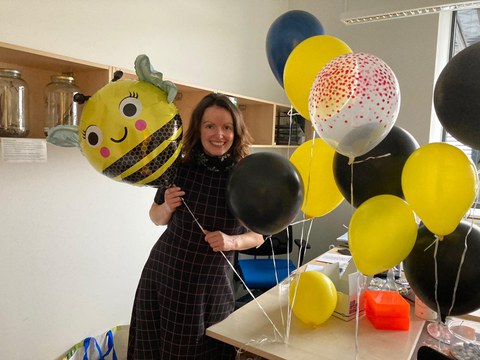Jan 21, 2021
Feodor Lynen Fellowship for Dr. Anja Buttstedt

Dr. Anja Buttstedt after the farewell in B CUBE
Dr. Anja Buttstedt from the B CUBE - Center for Molecular Bioengineering at TU Dresden received Feodor Lynen Fellowship from the Alexander von Humboldt (AvH) Foundation. The funding will allow the scientist to continue her research on the evolution of new protein functions in 2021 at the University of Pretoria, Republic of South Africa.
Dr. Buttstedt has been a TU Dresden Open Topic Postdoc at the B CUBE - Center for Molecular Bioengineering at TU Dresden since 2017. Her research follows her long-term passion for honey bees which started already in 2011 during her postdoctoral research at the University of Agricultural Sciences and Veterinary Medicine in Cluj-Napoca, Romania. Since then, the fascination with honey bees and their lifestyle continued to fuel her drive to research the evolution of major royal jelly proteins in honey bees and other Hymenoptera.
“My model system are the major royal jelly protein or MRJPs,” says Dr. Buttstedt. The first MRJP was discovered in food jelly, which is secreted by honey bees to feed their larvae. Meanwhile, mrjp genes have also been found in other insect species of the order Hymenoptera, including other bees, wasps and ants. Most of the other species besides the honey bees have a single mrjp gene. However, honey bees have been found to have as many as ten copies of that gene (mrjp1-10). Such gene multiplications are known to be major drivers of evolution. “The function of the original copy of the gene remains unchanged but other copies can have small modifications which might offer small enhancements and increase the fitness of the organism,” explains Dr. Buttstedt.
The researcher is interested in how and in which species the mrjp gene multiplied as well as whether the single copy of the gene carries the same function in all species. “For years, MRJPs have only been associated with a dietary role, being the main source of protein for the developing honey bee larvae,” continues Dr. Buttstedt. “However, our research shows that at least MRJP1 has other functions. MRJP1 assembles with the protein apisimin and the plant sterol 24-methylenecholesterol (24MC) into long fibrillary structures ensuring the high viscosity of royal jelly, the food that is only fed to queen larvae. It is extremely important for the development of honey bee queens. The queen larvae are raised in specialized queen compartments which are attached to the lower edge of a honeycomb. Queen larvae are essentially hanging from the ceiling of these compartments with the protein fibrils preventing them from falling out.”
Funded by the Feodor Lynen Fellowship Dr. Buttstedt will join Dr. Yusuf Abdullahi Ahmed at the Social Insects Research Group at the Department of Zoology and Entomology, University of Pretoria, Republic of South Africa. Her research project in Pretoria will focus on investigating further the molecular basis for the formation of the MRJP/apisimin/24MC complex.
